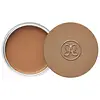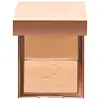Anastasia Beverly Hills Cream Bronzer Versus Patrick Ta Major Skin Crème Foundation and Finishing Powder Duo
What's inside
What's inside
 Key Ingredients
Key Ingredients

 Benefits
Benefits

 Concerns
Concerns

 Ingredients Side-by-side
Ingredients Side-by-side

Phenyl Trimethicone
Skin ConditioningSilica
AbrasiveDimethicone
EmollientBis-Diglyceryl Polyacyladipate-2
EmollientIsononyl Isononanoate
EmollientMica
Cosmetic ColorantMicrocrystalline Wax
Emulsion StabilisingSorbitan Olivate
EmulsifyingSynthetic Fluorphlogopite
Synthetic Wax
AbrasiveOctyldodecanol
EmollientTriethoxycaprylylsilane
Sorbitan Isostearate
Emulsifying1,2-Hexanediol
Skin ConditioningPolyhydroxystearic Acid
EmulsifyingAluminum Hydroxide
EmollientEthylhexyl Palmitate
EmollientIsopropyl Myristate
EmollientIsostearic Acid
CleansingLecithin
EmollientPolyglyceryl-3 Polyricinoleate
EmulsifyingTocopheryl Acetate
AntioxidantCaprylyl Glycol
EmollientEthylhexylglycerin
Skin ConditioningTitanium Dioxide
Cosmetic ColorantIron Oxides
CI 77742
Cosmetic ColorantPhenyl Trimethicone, Silica, Dimethicone, Bis-Diglyceryl Polyacyladipate-2, Isononyl Isononanoate, Mica, Microcrystalline Wax, Sorbitan Olivate, Synthetic Fluorphlogopite, Synthetic Wax, Octyldodecanol, Triethoxycaprylylsilane, Sorbitan Isostearate, 1,2-Hexanediol, Polyhydroxystearic Acid, Aluminum Hydroxide, Ethylhexyl Palmitate, Isopropyl Myristate, Isostearic Acid, Lecithin, Polyglyceryl-3 Polyricinoleate, Tocopheryl Acetate, Caprylyl Glycol, Ethylhexylglycerin, Titanium Dioxide, Iron Oxides, CI 77742
Lac Powder
Skin ConditioningSilica
AbrasiveMica
Cosmetic ColorantLauroyl Lysine
Skin ConditioningZinc Stearate
Cosmetic ColorantNylon-12
Kaolin
AbrasiveOctyldodecyl Stearoyl Stearate
EmollientDimethicone
EmollientPolymethylsilsesquioxane
Polysilicone-11
Isononyl Isononanoate
EmollientMagnesium Myristate
Magnesium Ascorbyl Phosphate
AntioxidantAnthemis Nobilis Flower Water
MaskingTocopheryl Acetate
AntioxidantSodium Benzoate
MaskingPotassium Sorbate
PreservativeCaprylyl Glycol
EmollientPhenoxyethanol
PreservativeCitric Acid
BufferingHexylene Glycol
EmulsifyingLaureth-12
EmulsifyingTriethoxycaprylylsilane
CI 77891
Cosmetic ColorantCI 77491
Cosmetic ColorantPPG-3 Benzyl Ether Myristate
EmollientEthylhexyl Isononanoate
EmollientDivinyldimethicone/Dimethicone/Phenylsilsesquioxane Crosspolymer
Polyethylene
AbrasivePentaerythrityl Tetraisostearate
EmollientBis-Stearyl Dimethicone
EmollientButyl Acrylate/Hydroxypropyl Dimethicone Acrylate Copolymer
Ethylhexyl Palmitate
EmollientIsopropyl Myristate
EmollientLecithin
EmollientPolyhydroxystearic Acid
EmulsifyingPolyglyceryl-10 Polyricinoleate
EmulsifyingPentaerythrityl Tetra-Di-T-Butyl Hydroxyhydrocinnamate
AntioxidantIsostearic Acid
CleansingLac Powder, Silica, Mica, Lauroyl Lysine, Zinc Stearate, Nylon-12, Kaolin, Octyldodecyl Stearoyl Stearate, Dimethicone, Polymethylsilsesquioxane, Polysilicone-11, Isononyl Isononanoate, Magnesium Myristate, Magnesium Ascorbyl Phosphate, Anthemis Nobilis Flower Water, Tocopheryl Acetate, Sodium Benzoate, Potassium Sorbate, Caprylyl Glycol, Phenoxyethanol, Citric Acid, Hexylene Glycol, Laureth-12, Triethoxycaprylylsilane, CI 77891, CI 77491, PPG-3 Benzyl Ether Myristate, Ethylhexyl Isononanoate, Divinyldimethicone/Dimethicone/Phenylsilsesquioxane Crosspolymer, Polyethylene, Pentaerythrityl Tetraisostearate, Bis-Stearyl Dimethicone, Butyl Acrylate/Hydroxypropyl Dimethicone Acrylate Copolymer, Ethylhexyl Palmitate, Isopropyl Myristate, Lecithin, Polyhydroxystearic Acid, Polyglyceryl-10 Polyricinoleate, Pentaerythrityl Tetra-Di-T-Butyl Hydroxyhydrocinnamate, Isostearic Acid
Ingredients Explained
These ingredients are found in both products.
Ingredients higher up in an ingredient list are typically present in a larger amount.
Caprylyl Glycol is a humectant and emollient, meaning it attracts and preserves moisture.
It is a common ingredient in many products, especially those designed to hydrate skin. The primary benefits are retaining moisture, skin softening, and promoting a healthy skin barrier.
Though Caprylyl Glycol is an alcohol derived from fatty acids, it is not the kind that can dry out skin.
This ingredient is also used as a preservative to extend the life of products. It has slight antimicrobial properties.
Learn more about Caprylyl GlycolDimethicone is a type of synthetic silicone created from natural materials such as quartz.
What it does:
Dimethicone comes in different viscosities:
Depending on the viscosity, dimethicone has different properties.
Ingredients lists don't always show which type is used, so we recommend reaching out to the brand if you have questions about the viscosity.
This ingredient is unlikely to cause irritation because it does not get absorbed into skin. However, people with silicone allergies should be careful about using this ingredient.
Note: Dimethicone may contribute to pilling. This is because it is not oil or water soluble, so pilling may occur when layered with products. When mixed with heavy oils in a formula, the outcome is also quite greasy.
Learn more about DimethiconeEthylhexyl Palmitate, also known as octyl palmitate, is created from 2-ethylhexyl alcohol and palmitic acid. It is a fatty acid ester.
The fatty acid content of Ethylhexyl Palmitate makes it an emollient. Emollients help soften and hydrate your skin by trapping moisture within.
Ethylhexyl Palmitate is also used to help improve the texture of cosmetics. It helps other ingredient dissolve in products and help disperse ingredients more evenly.
You'll likely find this ingredient in sunscreen, as it is often used to mix UV-blocking ingredients such as avobenzone and ethylhexyl triazone.
It can also help stabilize the fragrances in a product as a fragrance fixative.
Ethylhexyl Palmitate can be used to substitute mineral oil.
Due to its high fatty acid content, it may not be fungal-acne safe.
Learn more about Ethylhexyl PalmitateIsononyl Isononanoate is a synthetic skin-conditioner and texture enhancer. It is created from nonanoic acid, a fatty acid found in cocoa and lavender oil.
As an emollient, Isononyl Isononanoate helps keep your skin soft and smooth. This is because emollients create a barrier on the skin to trap moisture in.
Isononyl Isononanoate helps give products a velvet feel and improves spreadability.
Learn more about Isononyl IsononanoateIsopropyl Myristate is an emollient, thickening agent, and texture enhancer. It is created from isopropyl alcohol and myristic acid.
It is used to help other ingredients be better absorbed. It is also an emollient and may help soften and hydrate the skin.
The comedogenic rating of this ingredient depends on the concentration. Lower amounts results in a lower rating.
Isopropyl Myristate may not be fungal acne safe. It can potentially worsen acne prone skin.
Learn more about Isopropyl MyristateIsostearic acid is a saturated fatty acid. Its structure makes it a great surfactant.
Surfactants help decrease the surface tension between two liquids. This property also makes it an effective emulsifier. Emulsifiers help prevent waters and oils from separating in a product.
Isostearic Acid is created from oleic acid.
This ingredient may not be Malassezia folliculitis, or fungal-acne safe.
Learn more about Isostearic AcidLecithin is a term for a group of substances found in the cell membranes of plants, animals, and humans. They are made up of mixture of phospholipids.
This ingredient has emollient and emulsifying properties.
As an emollient, lecithen helps soften the skin and creates a barrier to keep moisture in.
As an emulsifier, it also helps prevent water and oil ingredients from separating. Lecithin can also help ingredients be better absorbed by the skin.
This is because the phospholipids in lecithin produce liposomes. Liposomes help other ingredients get through the skin barrier.
Depending on the source of this ingredient, lecithin may not be fungal acne safe. This is because some sources of lecithin come from soybean oil, which may feed the malassezia yeast that feeds fungal acne.
We recommend reaching out to the brand you are purchasing from to inquire about the source of their lecithin.
Some other names for this ingredient include soy lecithin and deoiled soy lecithin.
Learn more about LecithinMica is a naturally occurring mineral used to add shimmer and color in cosmetics. It can also help improve the texture of a product or give it an opaque, white/silver color.
Serecite is the name for very fine but ragged grains of mica.
This ingredient is often coated with metal oxides like titanium dioxide. Trace amounts of heavy metals may be found in mica, but these metals are not harmful in our personal products.
Mica has been used since prehistoric times throughout the world. Ancient Egyptian, Indian, Greek, Roman, Aztec, and Chinese civilizations have used mica.
Learn more about MicaPolyhydroxystearic Acid is a soft wax made from castor oil.
It is is a texture thickener, emulsifier, and film-former. Emulsifiers prevent ingredients from separating, such as oils and waters.
Polyhydroxystearic Acid may not be fungal acne safe.
Learn more about Polyhydroxystearic AcidSilica, also known as silicon dioxide, is a naturally occurring mineral. It is used as a fine, spherical, and porous powder in cosmetics.
Though it has exfoliant properties, the function of silica varies depending on the product.
The unique structure of silica enhances the spreadability and adds smoothness, making it a great texture enhancer.
It is also used as an active carrier, emulsifier, and mattifier due to its ability to absorb excess oil.
In some products, tiny microneedles called spicules are made from silica or hydrolyzed sponge. When you rub them in, they lightly polish away dead skin layers and enhance the penetration of active ingredients.
Learn more about SilicaTocopheryl Acetate is AKA Vitamin E. It is an antioxidant and protects your skin from free radicals. Free radicals damage the skin by breaking down collagen.
One study found using Tocopheryl Acetate with Vitamin C decreased the number of sunburned cells.
Tocopheryl Acetate is commonly found in both skincare and dietary supplements.
Learn more about Tocopheryl AcetateTriethoxycaprylylsilane is a silicone used to bind and stabilize ingredients.
As an emulsifier, it helps prevent ingredients from separating. This can help elongate the shelf life of products.
Triethoxycaprylylsilane is often used to coat mineral sunscreens ingredients to help give a better feel. It also helps reduce oxidative stress in sunscreens.
Learn more about Triethoxycaprylylsilane